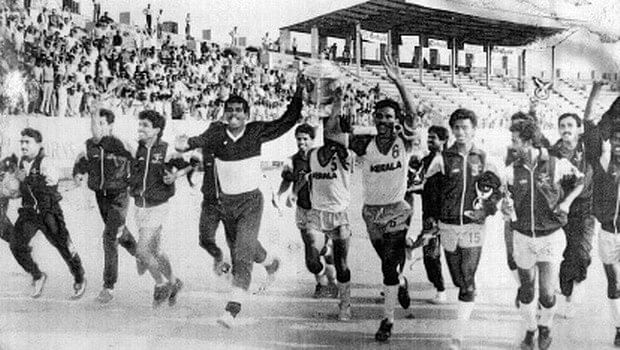
SK Indian Football Tribute: VP Sathyan - Remembering the life of a legend
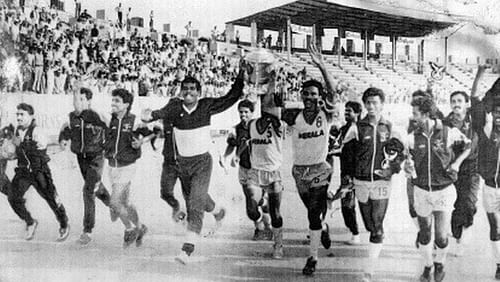
26th July, 1986 - THE goal
The score read India 2 – South Korea 3. Thirty-five odd yards away from the opposition goal, the ball bounced towards him. Generally, his job description – that of a holding midfielder – would have entailed a quick pass sideways, to enable the more creative of the lot to try and work their magic. A thought flashed across his mind; maybe the pass wasn’t really the best option. Maybe he should shoot.
After all, he had done it before.
As a teenager playing in the rain-filled mush-pits that passed for football fields back in Mekkunnu - the idyllic little village he called home - and across his home district of Kannur, he had been known for the ferociousness of his shot.
He had kept this reputation up even amongst the fiercely competitive footballing mini-leagues that Kerala called its own. Playing first for Spirited Youth Club as a 17-year-old, and then for Lucky Stars Club, he built his reputation, finally getting his big break when he joined arguably the strongest football team in the state – Kerala Police.
A stopper-back (what we would call a centre-back these days) by trade; the rigid structure demanded by professional football saw him foray forward a lot less than he was used to, but whenever he cocked that right leg of his, goalkeepers knew they would be in for a tough time.
As the ball bounced toward him - almost in slow motion he felt – his eyes narrowed; if they had known him better, they would have known what was coming.
They didn’t know him better, though. After all, it had been less than a year ago that he had been selected into the national squad. No one really knew what to expect of this tough looking young defender.
P.K. Banerjee though, a wily old tactician who had seen quite lot in his 15 years as a national player and nearly 14 years as national coach, had had one of those quirky moments that comes when you combine experience, wisdom, and plain ol’ intuition – he had asked the young Kerala Police central defender to play the sweeper role (what we would now call the Makelele role), screening his defence and adding bite to India’s midfield.
And that’s where he found himself, in the middle of the park, as the ball reached his right boot.
So what if this wasn’t playing against his friends in an abandoned paddy field in Chokli, he thought; what if he wasn’t up against Travancore Titanium in one of those numerous tournaments they held at the Calicut Corporation stadium?
So what if he was up against one of Asia’s strongest sides in the continent’s oldest footballing competition (albeit their B-team, which does nothing to take the sheen away from the feat)? No matter the grandness of the stage, or the pressure of the situation, he knew he could do it again.
After all, Vatta Parambath Sathyan had done it before.
The ball left Sathyan’s boot with the screech of a banshee, hitting the back of the net with a velocity that strained every strand of that wonderfully well woven net in the Merdeka stadium goal. 3-3. India had drawn level. With a well-taken goal by Mauricio Alfonso, India pulled off the comeback to seal the semifinal spot that was on the line this Group A game.
India would go on to lose the subsequent semi to a rather talented, but relatively minor Czechoslovakian outfit (a fighting 1-0 loss), but the over-riding memory of that tournament would be that spectacular goal by Sathyan.
The rise of Sathyan, and with him, Kerala Football
Back in the good ol’ days, the ultimate club footballing competition in the land was the legendary Federation Cup (still played, today as a sort of FA Cup equivalent to the I-League).
And Cup glory had till then been concentrated in the grand old city of Calcutta and her three near-mythical institutions – Mohun Bagan, East Bengal, and Mohammedan Sporting. In the late eighties, though, the Goans of Salgaocar rose to the challenge seizing two straight victories (’88 and ’89).
Then along came Kerala Police (KP), with the footballing genius of C.V. Pappachan, the solidity of Saraf Ali, and the force of nature that was I.M. Vijayan. Teams from Kerala had always had the talent, but rarely the temperament, to go far into the competition.
All that changed when KP made Sathyan captain. Built like one of those grand mountain peaks of the Western Ghats that frame his state, and carrying with him the same easy air of grandeur, Sathyan inspired confidence across the rank and file of his talented team.
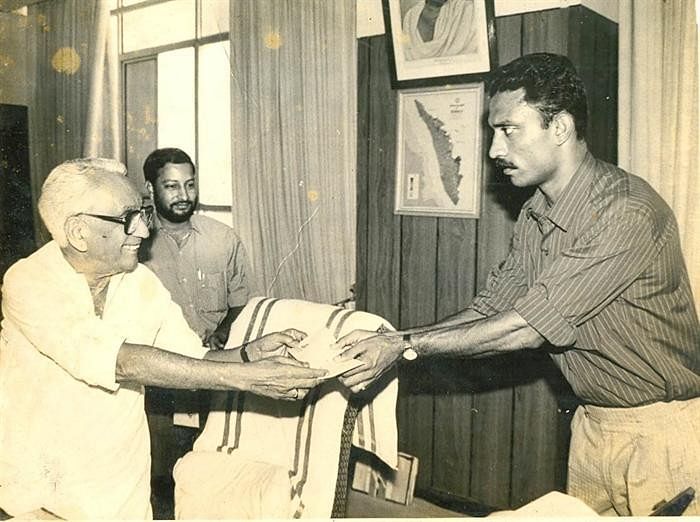
Playing at the peak of his considerable powers, Sathyan grabbed the Federation Cup by the scruff of its neck and laid his hands upon the long-elusive crown not once, but twice – consecutively (’90 and ’91) at that –in what was arguably the Golden Age of football in Kerala.
Just to underline his influence on the national game, he would lead Kerala to victory (twice, in ’91-’92 and ’92-’93) in arguably the more marquee competition - the inter-state extravaganza (well, it was back then) known as the Santosh Trophy. Since the inception of the trophy in 1941, Kerala had won the competition only once before (in ‘74).
Strong willed and iron- tough, with one of those bristly moustaches that screams machismo framing his face, Sathyan possessed the ability to read the game like he wrote it (as clichéd and overused as that phrase is, Sathyan’s phenomenal understanding of the game was evident in is playing style).
He also had uncommon bravery and skill in tackle (you really didn’t want to be on the receiving end of a full-blown Sathyan tackle) and the rare, oft-overlooked knack of keeping a metronomic passing rhythm going.
And he had that hammer of a shot on him. In his heyday, there wasn’t a player that could come close to competing with him for the title of “India’s Best Footballer”
The moves to Bengal and Madras
It wasn’t long before he decided that, to really up his game he would have to shift base to Calcutta (KP had also refused to give him a promotion at the time – and that too would have factored in his decision).
He would spend only two seasons there and he would return to Kerala homesick and with the beginnings of a strange depression lurking. His year each at Mohammedan and Mohun Bagan, though unhappy personally, had won him a lot of admirers –amongst the coaches in Bengal, and the football-educated crowd in the City of Joy.
They loved him for his almost eerie sense of calm when under pressure (the hallmark of a truly great sportsman) and his easy smile that so truly depicted the joy he took in playing the game he loved.
He was also a major factor in inducing I.M Vijayan and the twinkle-toed maestro Jo Paul Ancheri to move to Calcutta to further their careers – masterstrokes that helped the duo become two of the nation’s most celebrated footballers.
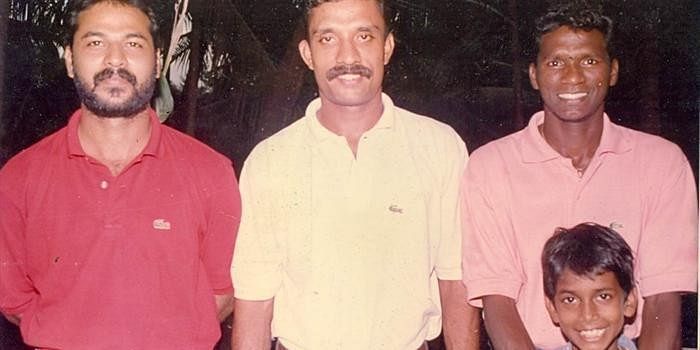
His return to Kerala Police didn’t go very well (he was once again refused a promotion - this time because he had left the service two years ago to go to Calcutta) and with the once mighty team slowly on a dangerous slide downhill, he decided to move to Madras and play for the little-known Indian Bank team in the lower tiers of the national game.
By then Sathyan had led India to a gold medal in the ’95 SAF Games and had been voted AIFF’s player of the year. Soon, though, after 80 games with the national team across a ten year career that saw its fair share of highs and lows, he hung up his boots, leaving the national team on the high of the SAF Games win.
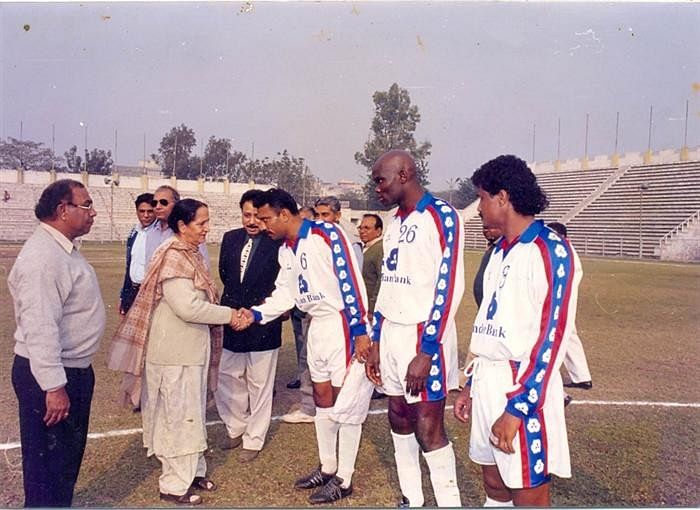
He would then play out the rest of his professional career at India Bank – with rather mediocre success by his high standards. He could have returned to Kerala Police, and a comfortable retired life, but that never was his thing – and he took up the challenge of coaching the club.
In his first season in charge, his vast understanding of the game was there for all to see as he coached the unfancied team all the way from the second division to the first division of the National Football League till date the only Madras (Chennai) based club to do so.
He managed to keep them up in the first season, though they were relegated in the next (hit hard by the unavailability of three of their top Sri Lankan players). After leaving this post, he was made a member of the AIFF Selection Committee (in 2004) and stayed on in Madras; till tragedy struck two years later.
One Train and Four Notes
Depression is one of the most belittled ailments a man can be stricken with. Not only is it hard to diagnose, it is incredibly hard for most people to accept as a crippling affliction. Sathyan, arguably suffering from the sort of depression that affects sportspeople once they step out of the limelight – imagine going from the darling of the people one day to obscure everyday commoner the next - it can be earth shattering and not many can adjust with it.
Sathyan had never been treated with the respect he deserved; why else would he have been treated the way he was in ’91? With the high of his success with Kerala Police propelling him to the limelight, Sathyan was chosen as the national captain.
The coach Josef Geli, though, gave the armband to Satyajit Chatterjee once the team reached Colombo. Whatever the reasons maybe, the fact that arguably the best player in the nation was treated so badly rankled – even though the great man never spoke a word about it then, or after.
Whatever the reason may be - on July the 18th, 2006, the soft-spoken Sathyan, a born-fighter if ever there was one, decided he had had enough.
That day we lost a great man; a man so underrated in his playing days yet so very instrumental in the success of every team he ever played for; a man whose inimitable talents had helped usher in the glory days of football in Kerala and India; a man whose innate understanding of the game could very well have helped shape the future of Indian football.
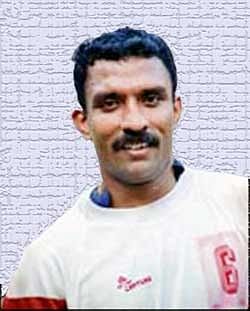
He left four notes on his self before he jumped in front of that speeding passenger train, the contents of which are personal, and immaterial to the larger issue at hand. For, while it says so in the notes, arguably it wasn’t financial troubles that killed him. We need to understand what the real reasons were.
Was it was the lack of respect or the visible lack of recognition he received, especially post-retirement? Was it a sudden bout of depression, and if it what brought it about? Let us not classify him as a coward, or a man who couldn’t face his troubles. Let us understand him.
Let us not remember him for the act of jumping in front of a train. Let us remember him for the smiles he painted on thousands of faces day in and day out. Let us remember him for the tremendous impact he had on the beautiful game in a land that often forgets the game even exists. Let us remember him for the Santosh Trophy and the Federation Cup victories. Let us remember him for that goal against South Korea.
Let us remember him not for the tragedy of his ending. Let us remember him for the glory of his heyday.
We owe it to him.
Post Script:. In a fitting tribute, Malayalam filmstar Jayasurya will act out the legend’s life in a film aptly titled Captain. I for one, can not wait for that one.